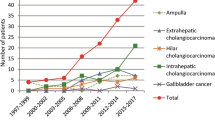Abstract.
Background/Purpose: A registry project for cancers of the biliary tract accumulated a total of 11 030 cases for 10 years. In the present study, registered cases were analyzed for information bearing on problems with the treatment of cancer of the biliary tract. The Japanese classification of lymph nodes was also considered on the basis of the results of this study.
Methods: In 11 030 cases, the site of cancer was the gallbladder in 4774, the bile duct in 4833, and the papilla of Vater in 1423. Those cases were analyzed with regard to patient survival according to the stage of disease and the extent of lymph node metastasis.
Results: More than 11 000 cases of cancer of the biliary tract have been registered to date from 158 member institutions of the Japanese Society of Biliary Surgery. While the 5-year survival rates for stage I gallbladder cancer and cancer of the papilla were 77% and 75%, respectively, those for stage I hilar or upper bile duct cancer and middle or lower bile duct cancer were 47% and 54%. For stage II and stage III disease, the 5-year survival rates were about 50% for gallbladder cancer and 30% or higher for cancer of the papilla, while survival was only 20% to 30% for bile duct cancer, regardless of specific site. For stage IV, the 5-year survival rate was unexpectedly high, being about 10% or higher for cancers at all sites, with 19% for cancer of the papillary region being the highest. Thus, there still seem to remain surgical indications for stage IV cancers. The lymph node metastasis rate was about 40% for cancers at all sites. Changes in surgical procedures to improve the 5-year survival rate in patients with n2 metastasis or less will be needed. Noncurative resection occurred frequently for cancers at all sites, particularly in cancers of the hilar or upper bile duct, accounting for 60% of cases or more. We have to recognize that measures to reduce inadvertent noncurative resection are fundamental to the treatment of cancer.
Conclusions: Considering the survival results according to specific lymph nodes involved, we concluded that the Japanese classification of lymph nodes, particularly hepatoduodenal ligament lymph nodes, should be reexamined, while another procedure to remove such lymph nodes completely should be developed.
Similar content being viewed by others
Author information
Authors and Affiliations
Additional information
Received: July 13, 2001 / Accepted: February 8, 2002
Acknowledgments. The authors thank the many doctors at 158 institutes for their cooperation in this registry, and thank Miho Suzuki for secretarial assistance.
Offprint requests to: T. Nagakawa
About this article
Cite this article
Nagakawa, T., Kayahara, M., Ikeda, S. et al. Biliary tract cancer treatment: results from the Biliary Tract Cancer Statistics Registry in Japan. J Hep Bil Pancr Surg 9, 569–575 (2002). https://doi.org/10.1007/s005340200076
Issue Date:
DOI: https://doi.org/10.1007/s005340200076




